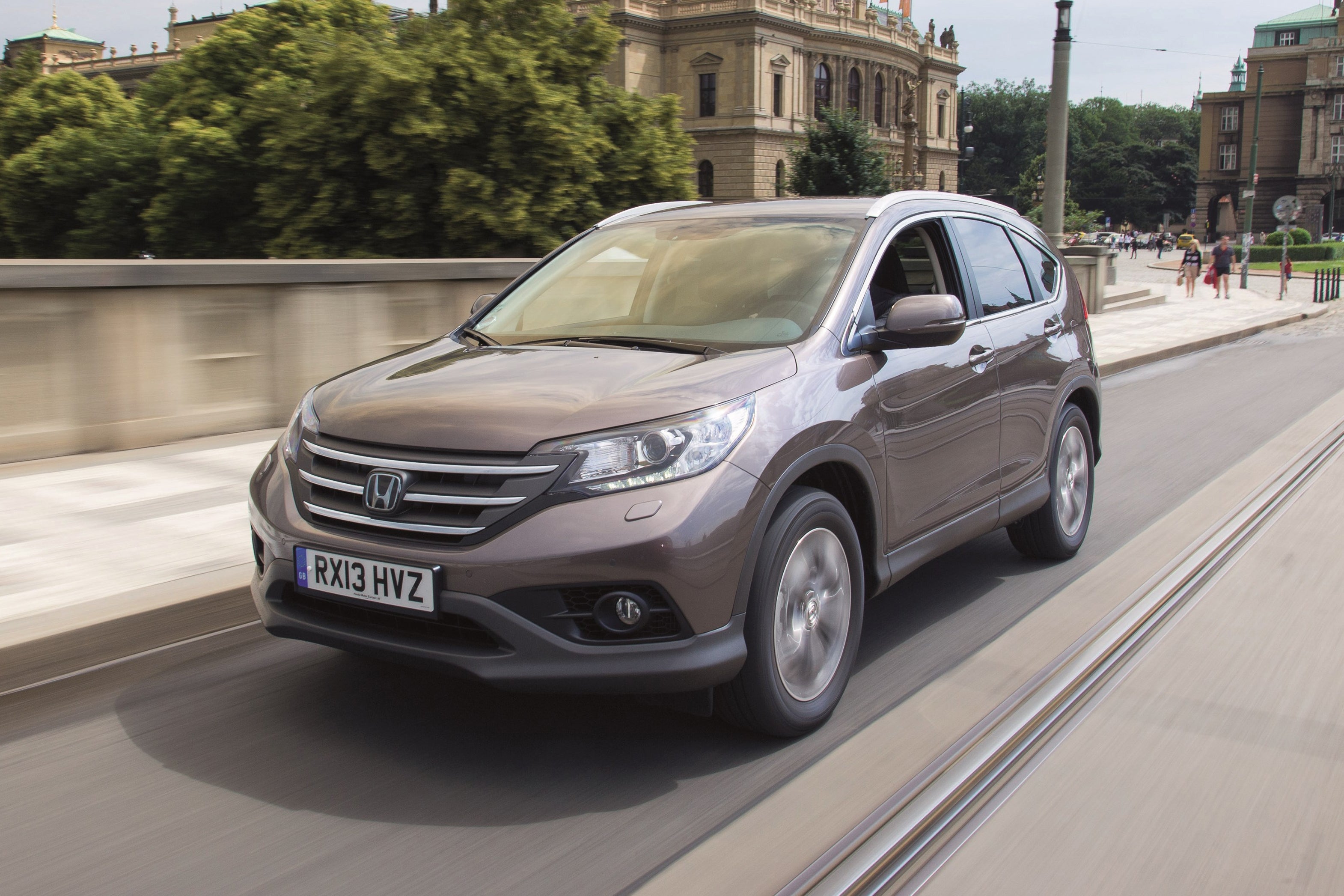Honda CR-V (2012-2018) Review
Written by Andrew Brady
Quick overview
Pros
- Punchy and efficient 1.6-litre i-DTEC engine
- Huge boot and spacious cabin
- Excellent build quality
Cons
- No seven-seat option
- Petrol versions not as impressive as diesels
- Top-spec models are very expensive
Overall verdict on the Honda CR-V
"In this Honda CR-V review we are taking a look at a mid-sized SUV that has a lot to offer potential buyers, but is probably forgotten about compared to more flashy alternatives. Hondas rarely aim to grab the limelight, but what the CR-V does well is offer impressive practicality, comfort and a low-effort driving experience."
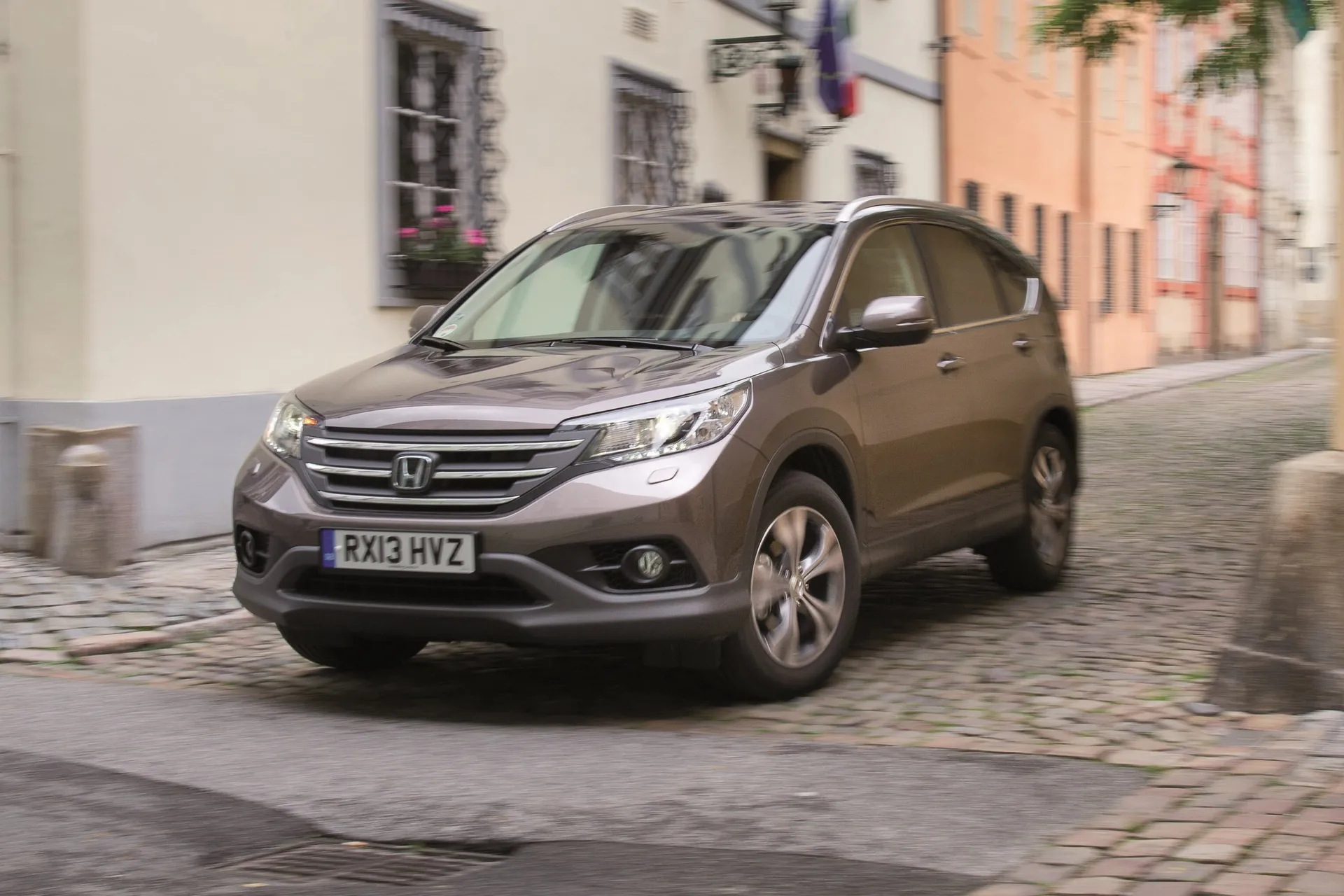
The Honda CR-V was one of the pioneers of the lifestyle SUV – designed for staying on the road, rather than venturing off it. This version of the CR-V (that’s ‘Compact Recreational Vehicle’) arrived in 2012, with production ending in 2018.
It would be a little harsh to say that the CR-V manages to impress without excelling in one particular area. Instead, we’ll call it one of the best all-rounders in a crowded market that’s filled with household names.
If we had to choose three key attributes, we’d select comfort, space and efficiency. It’s clear that Honda designed the CR-V to offer ease-of-use, flexibility and a comfortable driving experience. In these respects, it’s one of the class leaders.
At its heart is a flexible and spacious interior. The boot offers a cavernous 589 litres of space with all seats in use, which is more than enough for a pushchair, suitcases for a summer holiday or an expensive day out at a flat-pack furniture store.
But there’s more to the CR-V than a big boot, because the rear seats can be folded away with just the pull of two levers, which creates a flat floor and up to 1,669 litres of luggage capacity. If space is your final frontier, the Honda CR-V is out of this world.
Up front, there’s ample room for five adults, with even the middle rear seat offering more space than many rivals. If you’ve got a young and growing family, the CR-V offers plenty of room for growth.
All models have a generous level of standard equipment, including 17-inch alloy wheels, dual-zone climate control, cruise control, DAB digital radio and electric lumbar adjustment for the driver’s seat. The mid-range versions offer more kit, along with the option to add a suite of driver assistance systems.
Pick of the engines is the smooth, efficient, punchy and quiet 1.6-litre i-DTEC diesel, which is available with a choice of two outputs. Although the 160PS version is impressive, we’d recommend the 120PS unit for its low running costs and the remarkable ease at which it powers the CR-V.
The 2.0-litre i-VTEC petrol engine is less impressive, as is the 2.2-litre i-DTEC diesel, especially in the context of the smaller 1.6-litre unit. Entry-level versions of the CR-V are front-wheel drive, while the more expensive models get four-wheel drive as standard.
To drive, the Honda CR-V is a forgettable experience, but that’s arguably its greatest strength. It’s comfortable, relaxed, refined and, aside from some questionable interior plastics, surprisingly upmarket. It’s let down by the lacklustre petrol engine and the fact that some versions were very expensive when new. Not that this is a problem when you’re buying used. It’s not the most exciting option in a crowded market, but the Honda CR-V is a satisfying SUV to own and drive.
If you're looking for the newer version, you need our Honda CR-V (2018-) review.
Is the Honda CR-V right for you?
All things considered, the Honda CR-V is arguably one of the best SUVs you can buy. Sure, it doesn’t have the premium badge you might fancy, but in just about every other respect it’s a match for its more illustrious (and more expensive) rivals.
The diesel engines are remarkably efficient, especially if you opt for the 1.6-litre i-DTEC unit, plus there’s the option of four-wheel drive if required. It’s clear that somebody spent a considerable amount of time discovering what families want from their SUV, which is why the CR-V is one of the most practical and spacious cars in its class.
It’s not perfect. The petrol versions are best avoided, especially those with a five-speed manual gearbox. We’d also argue that the top-spec models are very expensive, with prices that edge them perilously close to premium-brand territory.
The Honda CR-V is almost completely devoid of excitement, which may or may not be a problem, depending on what you want from an SUV.
What’s the best Honda CR-V model/engine to choose?
The 1.6-litre i-DTEC diesel engine is the star of the Honda CR-V show, especially following the 2015 facelift. It’s no surprise that the relatively inefficient 2.2-litre i-DTEC diesel engine was dropped from the range.
There’s no need to look beyond the 120PS version of the 1.6 i-DTEC. It’s quiet at low speeds, reasonably quick to accelerate and hushed on the motorway. Up to 64.2mpg is achievable on a combined cycle, while a 0-62mph time of 11.2 seconds isn’t significantly slower than the more powerful engines.
The 160PS version is recommended if you regularly carry a full load or you intend to tow something with your Honda CR-V. Just ask yourself if you need the extra poke, because the 160PS unit is exclusively four-wheel-drive.
Even the entry-level Honda CR-V offers a generous level of standard equipment, so ask yourself if it’s worth spending extra for a more expensive model.
What other cars are similar to the Honda CR-V?
The Honda CR-V’s arch-rival is the Toyota RAV4. Like the CR-V, the RAV4 majors on comfort, reliability and efficiency, but the Toyota has the added benefit of an optional hybrid powertrain.
Beyond the RAV4, there’s a multitude of rivals, each one offering a variation on a theme. The Skoda Kodiaq offers better value for money and the option of seven seats. The Mazda CX-5 looks better and is nicer to drive. The Volkswagen Tiguan offers a strong image. The Kia Sportage offers a seven-year warranty. The Honda CR-V is one of the best all-rounders in a crowded market.
Comfort and design: Honda CR-V interior
"You sit high in the Honda CR-V, which provides a commanding view of the road ahead. The view out of the back isn’t as good, so it’s just as well a rear-view camera is standard on all but the entry-level model."
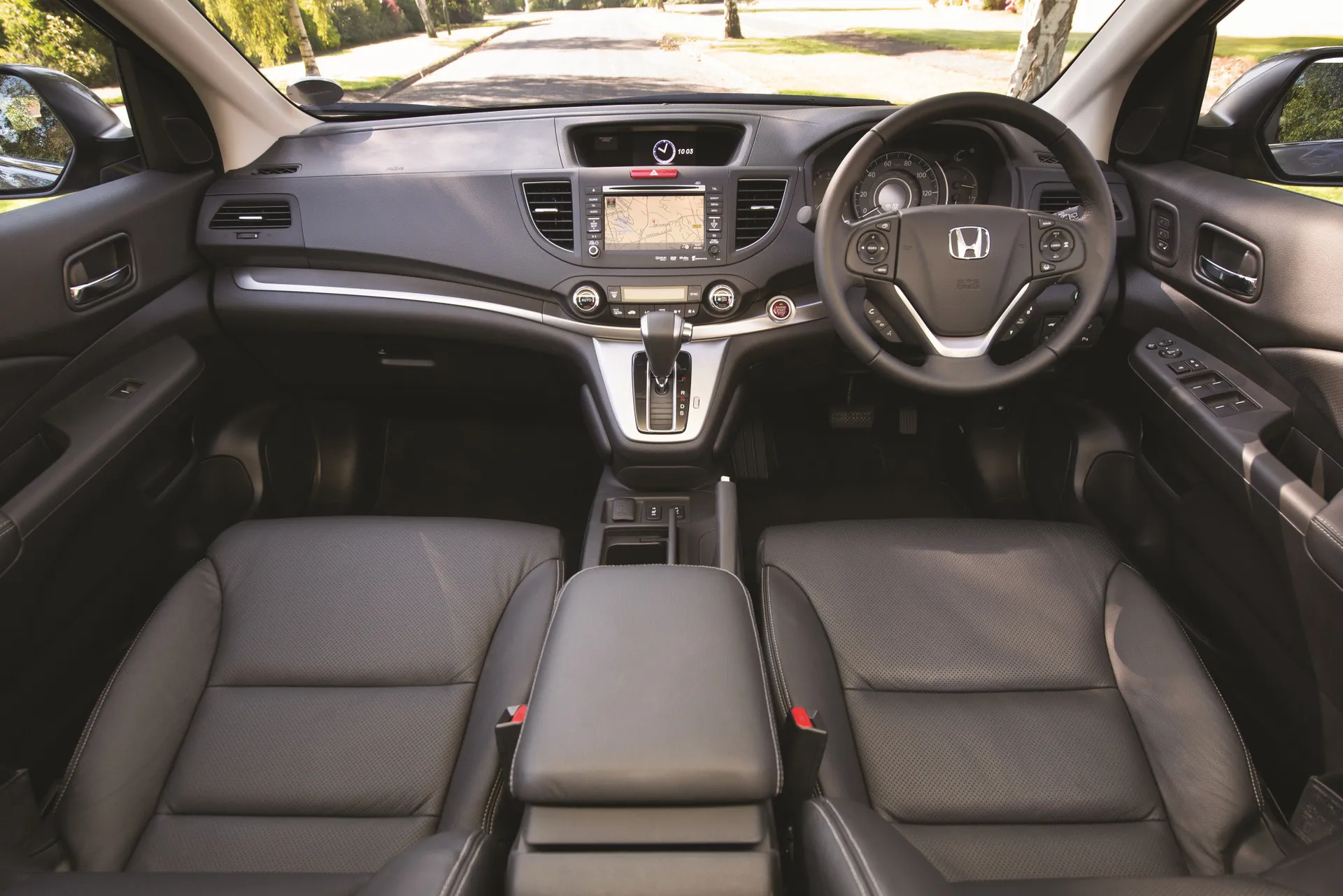
Although the dashboard looks a little busy, there’s a logical layout to the buttons and switches, while the high-set gearstick or shift lever is a familiar Honda approach. It means that the CR-V is an easy car to drive, in or out of the city.
The cabin in the entry-level Honda CR-V is a little sombre, but the mood is lifted in the other models by an alloy-effect panel running along the base of the swooping dashboard. Getting comfortable won’t be a problem thanks to a steering wheel that’s adjustable for height and reach.
Furthermore, all versions get a height-adjustable driver’s seat with electric lumbar support. Unfortunately, you need to progress to the entry- and mid-range versions to get leather, but hats off to Honda for getting the basics right.
Crucially, aside from the absence of leather seats and premium touches like an auto-dimming rear-view mirror and privacy glass, the most affordable CR-V feels no less comfortable than the most expensive version. In fact, thanks to the smaller 17-inch alloy wheels, the basic CR-V is actually the most comfortable.
Dual-zone climate control, steering wheel audio controls, cruise control and Bluetooth hands-free connectivity are standard across the range.
Quality and finish
Quality in the Honda CR-V is a bit of a mixed bag. While the top of the dashboard has a pleasingly upmarket feel, some of the plastics used in the lower part of the cabin feel rather cheap. The fabric seats in the entry- and mid-range models are also a little low-rent.
Although the entry-level CR-V offers a generous amount of kit, the absence of a leather-trimmed steering wheel gives it the feel of a poverty-spec vehicle. It’s not – it just feels that way.
What’s more important is the fact that everything feels robust and built to last. Perceived quality might be lower than some of the Honda CR-V’s premium rivals, but actual quality is far better.
There’s no doubt that the top trim levels feel more upmarket. The Alcantara/leather seats feel superb and deliver a more convincing feeling of quality than the full leather seats on the flagship CR-V. The top models also get heated seats, ambient lighting in the front footwells and ambient door lighting.
Regardless of the trim level, buying a post-facelift Honda CR-V will deliver the greatest feeling of quality. Honda doubled the thickness of the door seals, changed the carpet and tweaked the sound insulation to reduce cabin noise by six percent.
Infotainment: Touchscreen, USB, nav and stereo in the Honda CR-V
The entry-level Honda CR-V features a CD player and DAB digital radio integrated within the dashboard. Other features include an aux-in socket, USB port, four speakers, Bluetooth and steering wheel audios. It’s pretty basic, especially by 2020 standards, but it’s simple and easy to use on the move.
Other versions get a Honda Connect seven-inch touchscreen infotainment system with DAB digital radio. The upgraded system also gets a USB port, HDMI socket, six speakers and a pre-installed Aha app for internet connectivity and streaming services.
The top trim levels benefit from Garmin satellite navigation and eight speakers. An optional Honda 3D Sound adds a surround sound effect to the standard audio output.
The infotainment system is perfectly fine, but the graphics are woefully dated, looking like they’ve come straight out of the 1990s. It’s also a bit fiddly to move on the move, with some of the controls too slow to respond to user input.
Apple CarPlay and Android Auto aren’t available, although this is typical for a car of this age. A tablet holder was available as an option. No power input is necessary, but the tablet can be charged through the 12v socket if required.
Space and practicality: Honda CR-V boot space
In a battle of the SUVs, practicality would be the Honda CR-V’s ace card. It’s so big, you have to wonder why Honda never offered a seven-seat version, although at least that means we don’t have to criticise space in the third row.
The Honda CR-V's boot is massive, with 589 litres of space available with the five seats in place. Fold them away and the luggage capacity increases to 1648 litres of flat load space, or 1669 litres in cars with a space-saver spare wheel.
Honda’s one-motion folding seats mean it’s possible to lower the rear bench by pulling a couple of levers or straps. It's a beautifully simple system and you’re left with a perfectly flat floor. Only the rear wheelarches restrict the loading potential, although the bench splits 60/40 for added flexibility.
An electric tailgate is standard on the flagship CR-V, but it’s so slow to open or close we have to question its usefulness. Good luck getting your dog to stay still while the boot closes.
The tailgate opens to reveal a tall and wide opening, while the low lip is useful when you’re loading heavy items. All versions get hooks and a 12v socket in the boot, while an optional cargo pack adds a boot organiser and boot step protector. The positive vibes continue in the cabin, with the rear seats offering sufficient space for three adults. Headroom and legroom levels are good, even in the middle seat, aided by a shallow transmission tunnel. There are two ISOFIX points in the rear.
There’s also plenty of room in the front, where you’ll also find a large central storage bin, a big glovebox and three cupholders between the seats. What it lacks is the clever storage options offered by some rivals.
You’ll also find pockets on the back of the driver and passenger seats, while a sunglasses holder is standard across the range. Illuminated sun visor mirrors are standard on all except the entry-level version.
The Honda CR-V's dimensions are 4605mm in length, 2095mm width and 1685mm height.
Handling and ride quality: What is the Honda CR-V like to drive?
"The Honda CR-V majors on comfort and offers a very mature driving experience. It all feels very grown-up, which pushes the CR-V away from other mainstream SUVs and edges it closer to the premium players."
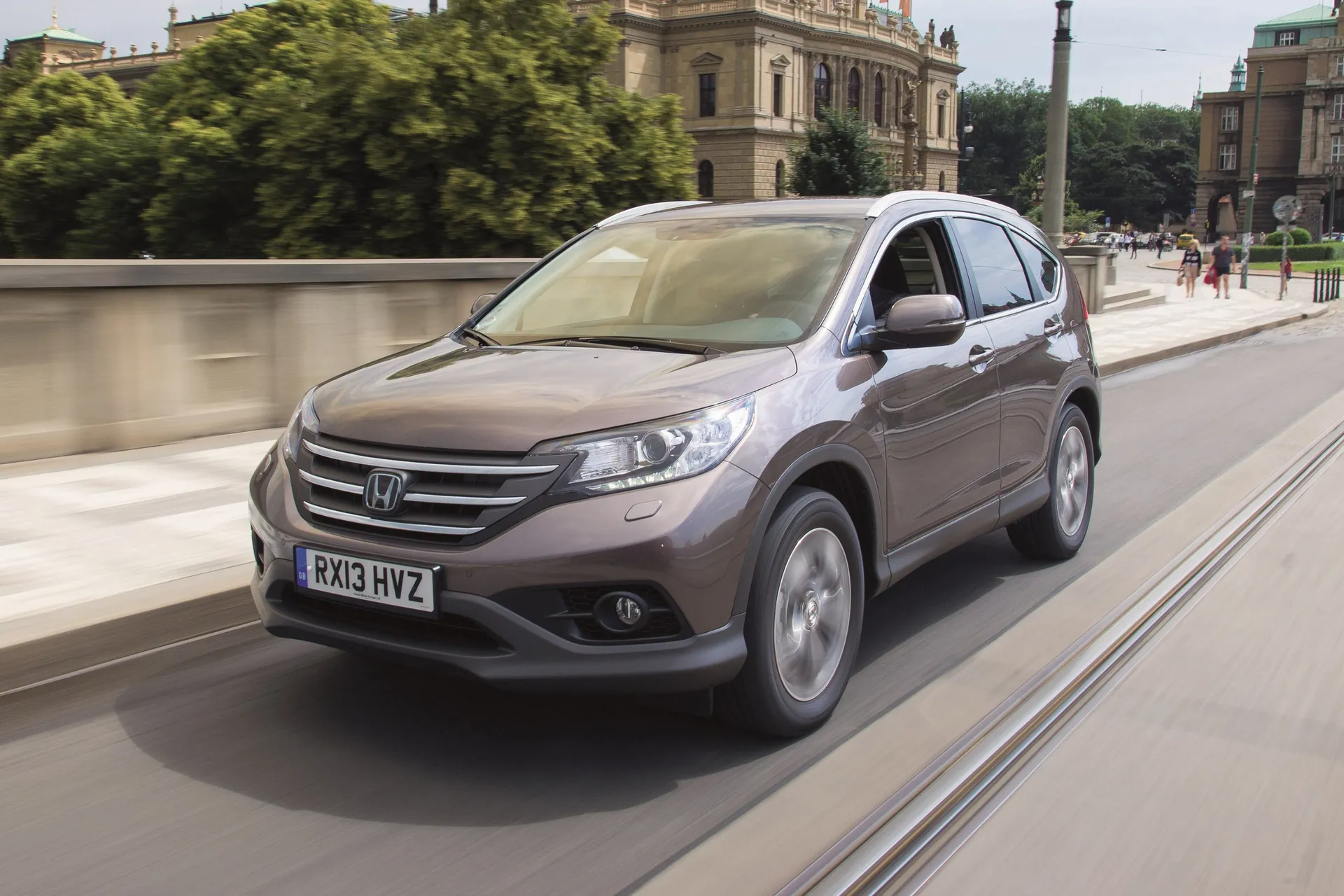
It works best on 16- and 17-inch alloy wheels, with anything larger upsetting the otherwise excellent ride comfort. On smaller rims, the CR-V deals with imperfections in the road with ease, feeling almost cushion-soft on all but the worst surfaces.
You have a choice: front-wheel drive or four-wheel drive. Of the two, the front-wheel-drive CR-V is the most agile, which makes it slightly more rewarding to drive. Not that it’s even the tiniest bit entertaining – it’s as though Honda has deliberately squeezed the joy out of the CR-V.
The steering is light and lifeless, although this makes it easy to manoeuvre in the city. There’s also a fair amount of body-roll when cornering, so you’ll soon learn to dial back any attempt at enthusiastic driving.
Although you won’t buy a four-wheel-drive Honda CR-V for serious off-roading, it’s perfectly fine for gravel tracks and green lanes. It also provides some added reassurance on wet and winter roads. For the most part, the four-wheel-drive CR-V will send power to the front wheels, with the 4x4 system kicking in when required. This maximises fuel economy and efficiency.
Overall, the CR-V isn’t an SUV designed for off-roading or country roads. It feels most at home on a motorway, where the comfortable seats, high driving position, good visibility and cruise control help to while away the long hours.
Stay within the car’s obvious limits and it feels safe, assured and predictable. If you’re after some fun behind the wheel, we’d suggest the Ford Kuga or Mazda CX-5.
What engines and gearboxes are available in the Honda CR-V?
The Honda CR-V launched in 2012 with the choice of a 2.0-litre i-VTEC petrol engine or a 2.2-i-DTEC diesel unit. A 1.6-litre i-DTEC diesel was added to the range in 2013, before the 2.2-litre was removed from the range in 2015.
Although downsizing from a 2.2-litre diesel to a 1.6-litre might seem like downgrading, the reverse is true. The 1.6-litre i-DTEC unit is a remarkably smooth, punchy, quiet and efficient engine, which makes it the default choice in the Honda CR-V.
There are two versions: 120PS and 160PS. On paper, the 120PS unit looks underpowered, especially when the 2.0 i-VTEC offers 155PS, but the 300Nm of torque gives it more punch than the petrol engine. Indeed, the petrol engine feels wanting, and you have to work it hard to make swift progress.
In 120PS guise, the 1.6 i-DTEC diesel will propel the CR-V to 62mph in 11.2 seconds. The 160PS version of the diesel engine offers a useful 350Nm of torque, but must be paired with four-wheel drive. You also get the option of a nine-speed automatic transmission, which was introduced in 2015.
Although nine cogs might seem like overkill, it works very well in the CR-V. It can be a little slow to react, but it’s preferable to the six-speed manual gearbox. The 160PS model is the only version of the CR-V to offer a 0-62mph time below 10 seconds, but we find it hard to look beyond a front-wheel-drive CR-V with the 120PS engine.
Refinement and noise levels
For the best feeling of refinement, opt for a post-facelift CR-V. Honda doubled the thickness of the door seals, changed the floor carpet and enhanced the sound insulation in the dashboard, doors and pillars. The CR-V also benefited from new seals on the end of the bonnet.
As a result, the cabin is six percent quieter than the pre-facelift CR-V. A small improvement, but the car was far from noisy, even before the changes.
The 160PS version’s nine-speed automatic transmission is also quieter than the old five-speed auto, especially at cruising speeds. It’s a far more pleasant driving experience than you got in a CR-V with the old five-speed automatic. Geek detail: the engine and transmission is 65kg lighter than the previous equivalent version. This makes it more efficient and slightly more agile.
It’s worth noting that the 2.0-litre i-VTEC petrol engine had to make do with the five-speed automatic, which is another reason why the diesel engines are preferable. Alternatively, opt for the six-speed manual, which is surprisingly slick and satisfying, helped in no small part by the raised position of the gearstick.
Safety equipment: How safe is the Honda CR-V?
The Honda CR-V was awarded a maximum five-star safety rating when it was crash-tested by Euro NCAP in 2013.
The individual scores were 93% for adult occupant protection, 74% for child occupant protection, 68 percent for pedestrian safety and 66% for safety assist systems.
Honda upgraded the CR-V safety arsenal in 2015, adding a new automatic low-speed braking system as standard, along with new adaptive cruise control. The intelligent system uses speed and brake control to adjust to the surrounding traffic. It was an optional extra on the top trim level, so you might have to search hard to find an example with the system fitted.
All post-facelift models feature standard cruise control, city braking, multiple airbags, brake assist, trailer stability assist, vehicle stability assist, hill-start assist, two ISOFIX points for child car seats and a tyre deflation warning system. Forward collision warning, traffic sign recognition, lane-departure warning and blind-spot information were optional on all except the entry-level CR-V. Collision mitigation braking, lane-keeping assist and intelligent cruise control were options on the top trim level.
Four-wheel-drive models also feature hill-descent control for safer downhill driving when travelling off-road. Front and rear parking sensors, a rear-view camera, an auto-dimming rear-view mirror, rain-sensing windscreen wipers and dusk-sensing headlights are standard on all except the basic model.
MPG and fuel costs: What does a Honda CR-V cost to run?
"Although the fuel economy figures were sourced using the old NEDC testing system, the 1.6-litre i-DTEC diesel will be the most efficient engine. The post-facelift CR-V offers up to 64.2mpg on a combined cycle when the 1.6-litre diesel is mated to a manual gearbox."
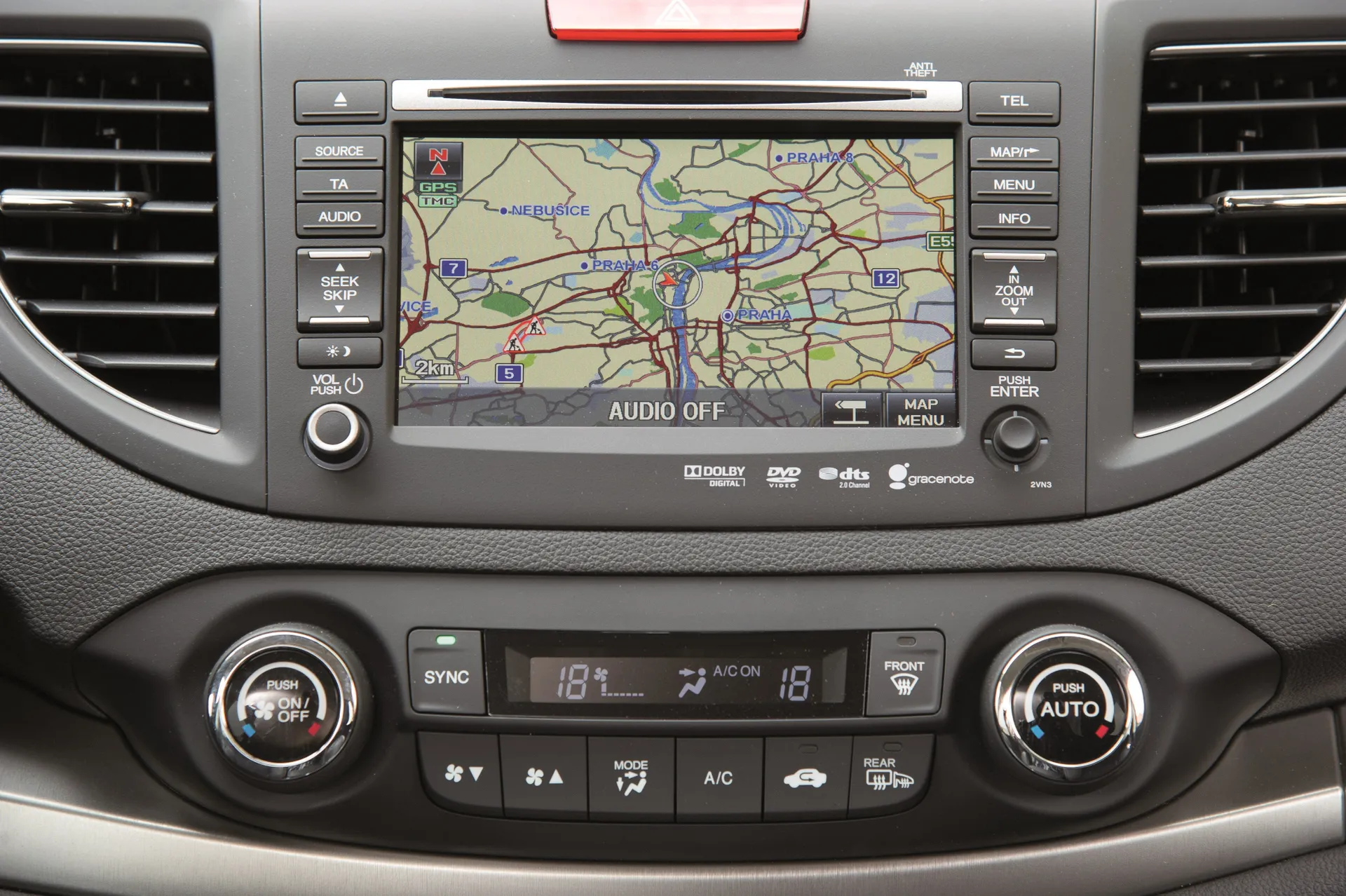
If you need a four-wheel-drive version, we’d recommend the nine-speed automatic transmission introduced in 2015. Available on the 160PS version of the 1.6-litre i-DTEC engine, up to 55.4mpg is possible on a combined cycle. That’s a penalty of around 2mpg over the manual version.
Fuel economy for the petrol engines is measured in the 30s, so these are best avoided.
How reliable is a Honda CR-V?
The Honda CR-V scored an impressive 9.48 out of 10 for reliability in the HonestJohn.co.uk Satisfaction Survey - a strong score in its own right, but that's not even the best score for a Honda.
As a brand Honda came 14th out of 30 manufacturers, which is almost a disappointing score for a brand with a deserved reputation for reliability, but the CR-V should make for a trustworthy companion as long as it has been well maintained.
Insurance groups and costs
The insurance groups range from 22 to 28, depending on the engine and trim level, so the Honda CR-V should be relatively cheap to insure, regardless of the model. Opting for the 1.6-litre i-DTEC diesel is the key to lowering your overall running costs.
Broadly speaking, the Toyota RAV4 will cost roughly the same to insure, but the group ratings are skewed by the hybrid version, which gets a rating of 34. The Skoda Kodiaq should be cheaper to cover, thanks to groups ranging from 12 to 26.
VED car tax: What is the annual road tax on a Honda CR-V?
If you’re buying a Honda CR-V registered on or after 1 April 2017, you’ll pay a flat rate of £165 a year, regardless of the CO2 emissions. The rate of Vehicle Excise Duty (VED, or road tax) varies for CR-V models registered on or before 31 March 2017.
The 1.6-litre i-DTEC diesel is the engine to choose if you want to minimise your tax outgoings. Thanks to CO2 emissions of 115g/km to 119g/km, the CR-V slots into VED band C, which means an annual rate of just £30.
With CO2 emissions as high as 180g/km, the 2.2-litre i-DTEC diesel falls into band I, which means VED of £265 a year. Other engines are more affordable.
How much should you be paying for a used Honda CR-V?
"A budget of £5000 will give you a choice of two cars: a late example of the older Honda CR-V, or an early version of the one we’re reviewing here. We’d recommend the later CR-V, not least for the extra space and additional safety requirement. You can expect to find a car with up to 150,000 miles on the clock."
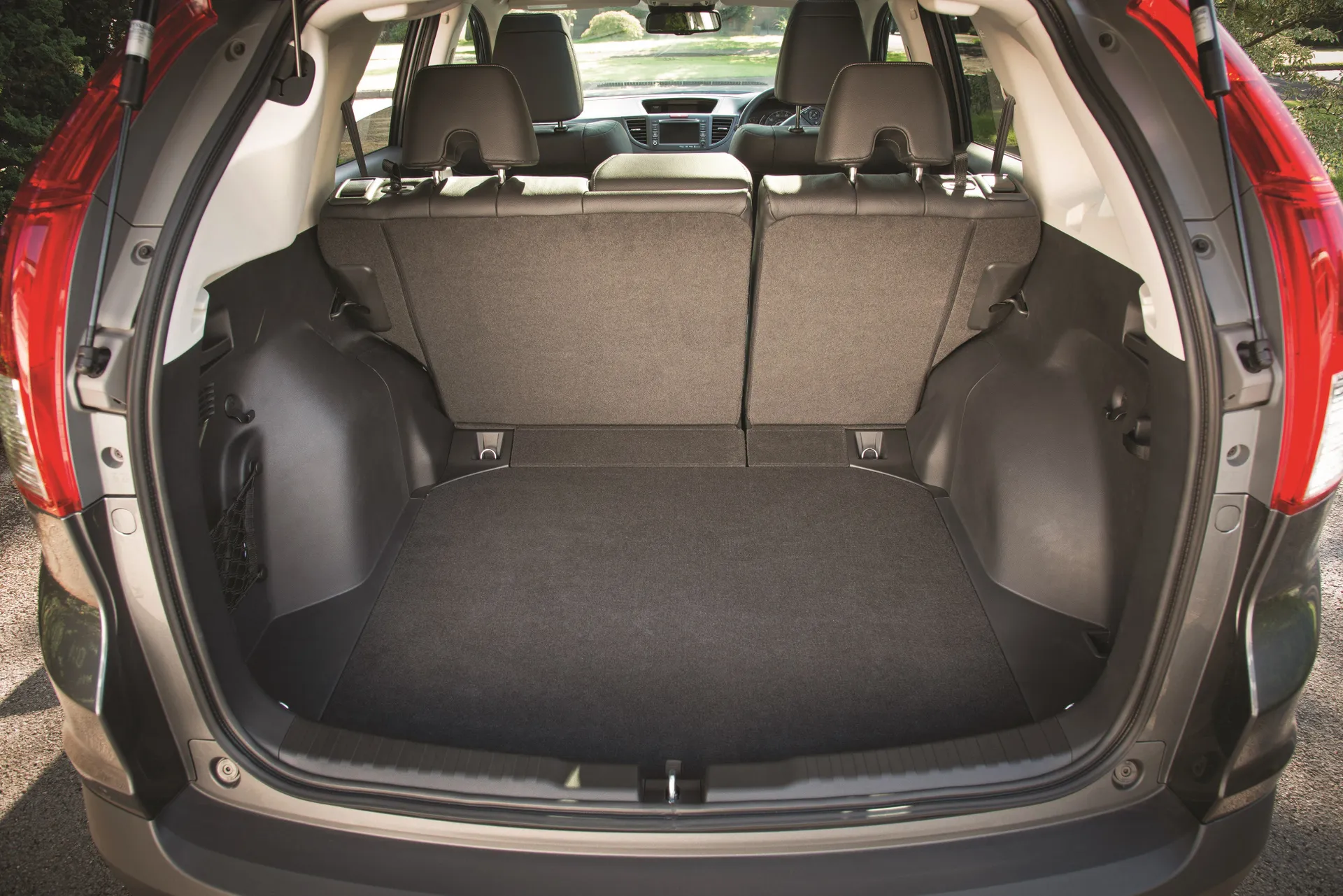
Stretching the budget to £10,000 unlocks the potential to buy a 2015 facelifted car, which is better to drive and offers more equipment.
The most you’ll pay is £22,500. For this you’ll get a 2017 or 2018 CR-V with a few thousand miles on the clock. If you fancy a Black Edition, bank on spending at least £11,000 on the original version, or £15,000 on the newer model.
Trim levels and standard equipment
The entry-level Honda CR-V S trim is far from basic when it comes to standard equipment. Highlights include 17-inch alloy wheels, dual-zone climate control, cruise control, front and rear electric windows, driver’s seat electric lumbar support, a CD player, DAB digital radio, one-motion fold-down rear seats and active city braking.
The Honda CR-V SE Plus adds a leather-trimmed steering wheel, a seven-inch touchscreen infotainment system, a rear parking camera, front and rear parking sensors, rain-sensing wipers, automatic headlights, an auto-dimming rear-view mirror and privacy glass.
Standard equipment on the Honda CR-V SR includes everything on the SE Plus, along with 18-inch alloy wheels, Alcantara/leather heated seats, HID headlights with auto levelling, active cornering lights, automatic high/low beam, Garmin satellite navigation and ambient lighting.
Finally, the Honda CR-V EX trim boasts everything on the SR, plus full leather interior, a panoramic sunroof, electric tailgate, electric adjustment for the driver’s seat and keyless entry/start.
Ask the heycar experts: common questions
What are the problems with the Honda CR-V?
Are Honda CR-Vs a good car?
Which is more reliable, the Honda CR-V or Toyota RAV4?
Get our latest advice, news and offers
Keep me updated by email with the latest advice, news and offers from heycar.
By submitting you agree to our privacy policy
